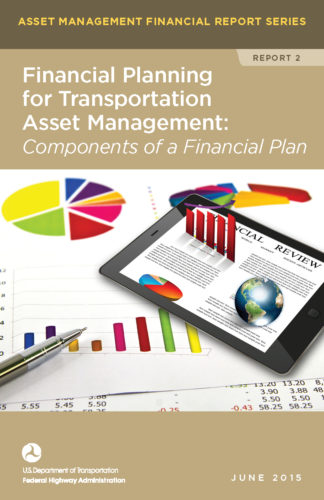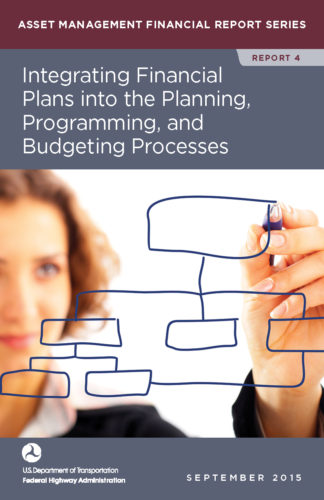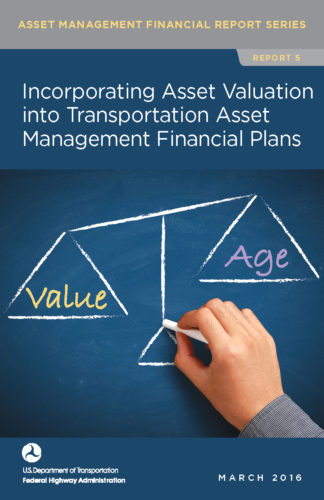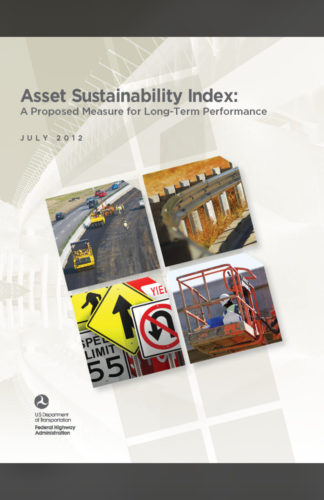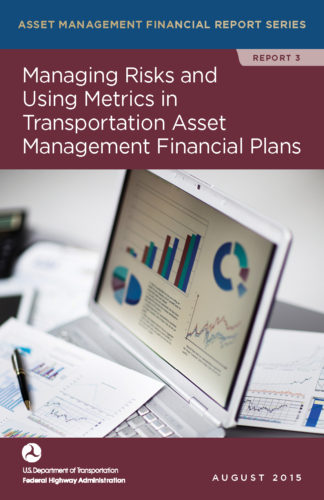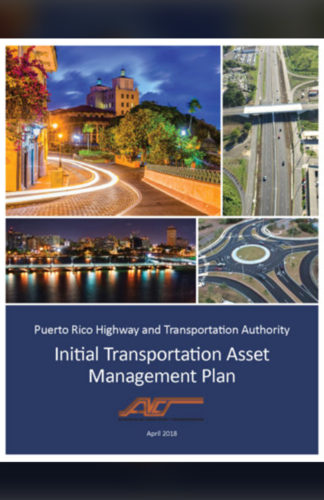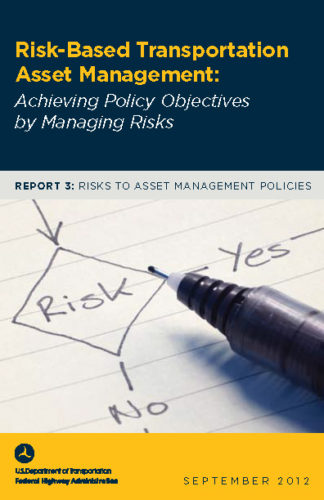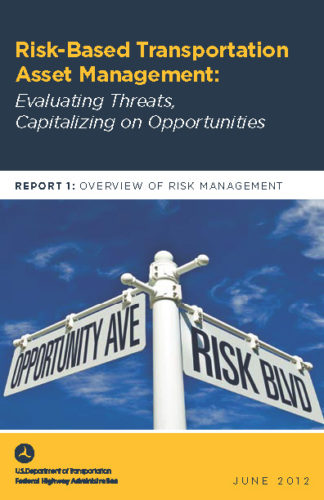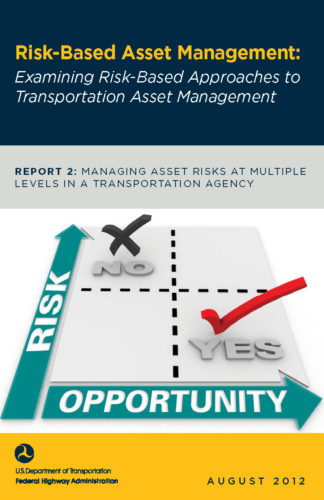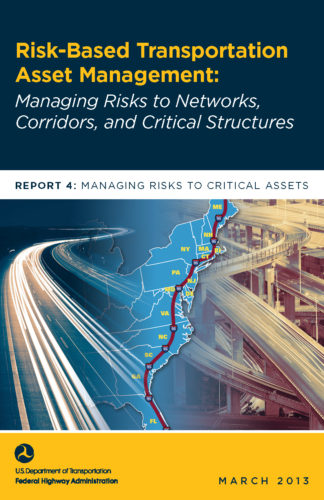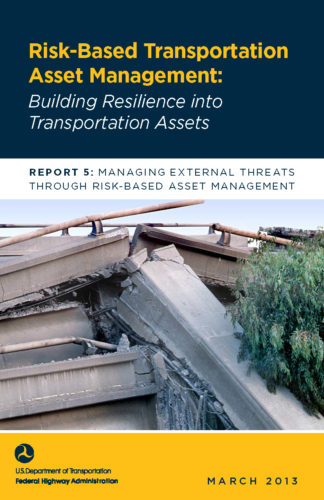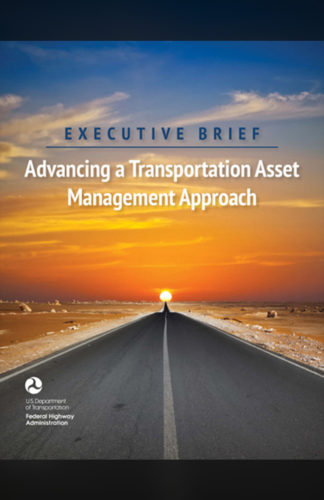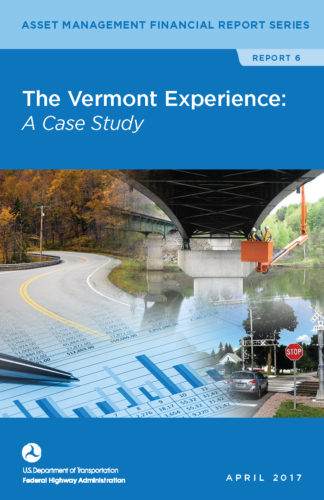EXPLORE OUR PROJECTS!
Following are brief descriptions of selected TAM projects:
FHWA – State Transportation Asset Management Gap Analysis: Completed TAM gap analyses for 9 states (Maryland SHA, Kentucky Transportation Cabinet, Mississippi DOT, Texas DOT, Puerto Rico Highway Transportation Authority, Nevada, Minnesota, Alaska and Idaho DOT).
In each of these efforts, engaged between 50 and 100 subject matter experts from each state DOT in surveys and interviews to capture the state of maturity of asset management. Shared international best practices as well as those from other state DOTs. Briefed and obtained feedback from the agency subject matter experts and leadership teams. The process involved researching and reviewing materials; surveying staff; conducting interviews; understanding asset management practices, assessing organizational support and technical expertise; analyzing agency asset conditions and performance data; risk management; and financial planning strategies and analysis in support of asset management. Conducted workshops to refine and validate findings, including briefing and obtaining feedback from agency leadership on workshop highlights. The final reports summarize the analysis of the agency’s asset conditions and processes, gaps and steps to improve the asset management practices, organizational gaps, and analysis capabilities for long-term sustainable, cost effective TAM. The final reports also include agency specific asset management implementation plans to help capitalize on the agency’s strengths and bridge the gaps identified. Concluded project by presenting to agency leadership, the agency’s technical, analytical, organizational and financial strengths and gaps, and recommended steps to address gaps.
State DOT Transportation Asset Management Plan Assistance: Assisted several state DOTs on various aspects of transportation asset management planning as they developed their 10-year Transportation Asset Management Plans. These include, Connecticut, Idaho, Iowa, Kentucky, Maryland, New Mexico, Rhode Island, Vermont, and Puerto Rico. StarIsis played significant roles in the development of TAM Plans at Kentucky, Idaho and Puerto Rico.
Beyond the Short Term- Transportation Asset Management (TAM) for Long Term Sustainability, Accountability and Performance: This 2010 report for FHWA, before the era of MAP-21 and FAST Act, and before the national focus on performance and sustainability, highlights TAM in light of growing efforts to demonstrate accountability and promote sustainability. The report examines and discusses national and international best practices for long term sustainability and performance of transportation assets. It reflects excellent understanding of challenges that DOTs face in implementing risk and performance based asset management at a time of aging infrastructure and funding limitations. It includes relevant international and national TAM best practices for adoption by state DOTs.
Advancing a Transportation Asset Management Approach: This report is a synthesis of best practices in state DOTs with mature asset and performance management. It provides executives with strategies used by peers to address and advance asset management in transportation agencies. It discusses the application of the asset management framework and decision-making process as a way to maximize investments for long-term sustainability, accountability and performance. It discusses how executives can change their organizations to fully utilize TAM. It documents the use of strategic planning, organizational theory, change management and organizational communication to shift an agency from a short-term, worst-first approach to a long-term, cost effective, sustainable and accountable Asset Management approach.
Roadside Asset Management in Utah DOT and Comprehensive TAM in North Carolina DOT:
Worked with over 15 DOTs on various aspects on asset management. These reports are examples of two such early efforts. “Managing and Maintaining Roadway Assets-The Utah Journey” and “Comprehensive TAM-The North Carolina Experience, Part Two” discuss two different asset categories. The first discusses innovative approaches to preserve, maintain and extend the service life of roadway assets while also addressing safety issues. The second report discusses the NCDOT’s journey, the challenges faced, the strategies implemented and organizational changes made to implement TAM in the DOT.
Ohio DOT Asset Management Program and System
Relevance: As Ohio DOT’s CIO, Ms. Varma, the President of Starisis was responsible for implementing “Ellis” an enterprise asset management system that linked the DOTs program of projects to achieving the system conditions and performance goals. It linked fiscal responsibility with the planning and programming process. Ellis captured the elements of each programmed project and calculated its contribution to the improvement of bridges and pavements. This allowed ODOT to estimate the amount of improvement it would achieve with a given program of projects. Business intelligence reports provided detailed and summary information regarding projects, capital budgets and related system conditions that allowed decision makers to make tradeoffs between projects and across asset categories.
Summary: The Ellis project-management, and asset-management system streamlined the planning and delivery process to support fiscally balanced, sustainable planning and project delivery by:
1) ensured organizational support by creating and actively engaging leaders and subject matter experts from the districts and headquarters in streamlining the business process and championing agency-wide use of the enterprise asset management system
2) facilitated data-driven decisions about asset conditions and performance regarding projects, capital budgets and related system conditions that allowed decision makers to make tradeoffs between projects and across asset categories
3) facilitated easy review and tracking of the long-term program of selected projects to ensure alignment with the DOT’s goals on asset condition and performance targets
4) implemented user friendly reporting to ensure that the program of projects implemented were those selected to achieve the DOT’s enterprise asset management goals
5) linked fiscal responsibility with the planning and programming process
6) Provided detailed and summarized business intelligence reports regarding performance gaps in critical business areas such as finance, operations and maintenance, program and project delivery, system and asset conditions, safety, and mobility
7) implemented technology solutions to formalize business improvements that accelerated data-driven decision-making in the Ohio DOT, and
8) integrated and routinized risk management into DOT operations
Selected projects include:
2016 AASHTO Guide for Enterprise Risk Management
Co-authored for NCHRP the country’s first enterprise risk management guide for transportation departments. It was adopted by AASHTO and published in 2016 as an official AASHTO risk management guide. It extensively explains the application of risk management at the enterprise, program, project, and activity levels. It addresses all aspects of risk management as described in the ISO 31000 standards, from setting the context, through all stages of identification, analysis, response, and monitoring. Its section on the Critical Review of the State of Practice summarizes best practices among U.S. and international transportation agencies, and among 5 leading U.S. corporations.
The section in the Guide on advanced tools illustrates the next frontier of risk management by analyzing sophisticated risk measurement and analysis tools such as decision trees, scenario analysis, and Monte Carlo simulation. The tools also demonstrate the ability to relate risk management to strategic planning, asset management, and performance management in an extensive risk management chapter that examines application of risk management in seven key DOT areas. These include: asset management; highway safety; external threats; financial resources; data and information; business operations; and programs and projects.
Risk-Based Transportation Asset Management: Evaluating Threats, Capitalizing on Opportunities:
This first FHWA report on risk-based asset management series and its accompanying literature review provide a synopsis of how risk management can be applied to transportation agencies, particularly in regard to managing physical assets. It includes definitions of risk and risk management from around the world. It also summarizes the major risk management frameworks as described by ISO, the International Road Federation and by transportation agencies in Australia, New Zealand and England.
It also includes relevant examples from the private sector and illustrates how they could be applied to a transportation setting. The fields of banking, insurance and finance all rely on risk management to protect organizational assets and to weigh risk/return opportunities. This report provides a thumbnail overview of all the issues addressed in the subsequent four reports.
Managing Asset Risks at Multiple Levels of a Transportation Agency:
This second of the five reports examines how risk can be managed at multiple levels in an organization to achieve a comprehensive enterprise-wide risk program. The report explains how risk can be managed at the agency, program, corridor, project, asset class or individual asset level. The report cites examples from several U.S. agencies including those in Minnesota, Utah, Florida, Washington and Ohio, that have applied forms of risk management. The report illustrates how the agencies are using risk management to improve decision making and to illustrate difficult tradeoffs to legislators and to the public. The reports also include examples of the diverse types of risks considered by the agencies include funding, political, physical risks, climatic risks and decision-making risks. It provides a framework for deploying risk management throughout an organization.
Achieving Policy Objectives by Managing Risks:
This third report examines how risk management is an effective tool for achieving strategic objectives and not only protecting an organization against threats or hazards. The report emphasizes the role that risk management plays in complementing performance management. While performance management serves to drive an organization toward its objectives, risk management serves as a navigational aid that identifies impediments and helps an agency to steer around or take advantage of them.
The report also includes a brief “how to” summary that an agency could use to stand up a risk management program. It describes the ISO framework and explains the steps necessary to create an effective risk management program. It describes the active role that executives need to play to instill a risk-based approach to decision making in their agencies. It summarizes private sector examples that are relevant to transportation agencies.
Managing Risks to Networks, Corridors and Critical Structures:
This report examines a risk-management perspective applied to critical corridors and other key assets. It illustrates the flexibility of risk management and how it could be applied not only programmatically but also to classes and categories of assets. For instance, it describes how the Florida Department of Transportation treats its key hurricane evacuation corridors from a risk-based perspective. It describes how Washington State used an economic-priority risk approach to set performance standards for critical freight corridors. It also summarizes how the North Carolina DOT used a tiered approach to justify higher asset conditions on high-risk networks, such as the Interstate Highway System, compared to lower-risk functional classes. The report anticipates many of the asset-condition issues departments are likely to face as they make financial tradeoffs on their assets based upon financial constraints.
Building Resilience into Transportation Assets:
The fifth report examines the use of risk management to address climate change and other extreme events that could disrupt transportation networks. It summarizes several recent reports including a New York State analysis of how Super Storm Sandy disrupted transportation networks and what the state needs to do to prepare for future events.
The report summarizes how risk management and asset management can help agencies improve the resiliency, redundancy and robustness of their transportation networks. It summarizes reports from FHWA and from international climate change organizations on how to conduct risk-based assessments of physical assets’ ability to withstand climatic events. The report builds from many U.S. examples such as how CalTrans and Washington DOT have assessed seismic risks and how rock fall programs provide an analog for risk-based mitigation programs.
Asset Management and Risk Management serve dual and complementary roles in relation to resilience. Although the type, nature and impacts of any given external threat is difficult to accurately predict, the resiliency created by sound asset management and risk management programs better prepares an agency to deal with a wide array of physical threats, and more quickly recover from them if they occur. Risk management can help identify, quantify and mitigate the threats to physical assets. Likewise, a sound asset management program increases infrastructure resiliency and robustness that reduces impacts caused by storms, floods or seismic events.
National Highway Institute Risk Management Instruction:
As Instructor, conducted the National Highway Institute’s Risk Management Training for eight state DOTs. This training course explains how risk management can be applied at the enterprise, program or project level. The course includes numerous exercises that lead participants through the identification of risks, the writing of risk statements, prioritization of risks and the development of a risk register that includes options for either treating or capitalizing upon the risk.
Vermont Agency of Transportation Risk Register:
Conducted workshops to assist the Vermont Agency of transportation in developing risk registers for multiple assets for its Transportation Asset Management Plan. Assistance included strategic advice on how to integrate risk-based asset management into the agency and how to develop an asset management plan. The agency addressed risks at the enterprise, program and activity levels. The first workshop in January of 2015 addressed risks to the agency’s financial plan, its asset management plan, and its strategic objectives by specifically addressing risks to pavements, bridges, roadside appurtenances, and finances. The workshop included training with extensive hands-on exercises in which participants identified, analyzed, and prioritized risks to the agency’s asset management, strategic, and financial objectives. The second workshop helped the agency develop a risk register for its enterprise and for key programs including its non-pavement and bridge assets, its traffic and safety objectives, and its budgeting, planning, and programming objectives.
State DOT Risk Management Assistance:
Led state (New Mexico, Connecticut, Maryland) and national level risk management workshops. Trained DOT personnel on identifying and prioritizing strategic risks and familiarized them with successful US and international strategies to address such risks. Assisted in developing the risk registers for asset management plans.
NCHRP 20‐24 (105) Launching U.S. Transportation Enterprise Risk Management Programs:
Organized and facilitated a workshop for executives on how to organize enterprise risk management efforts. More than 20 states attended the August 2015 session in Minneapolis. Along with a private‐sector risk manager, they discussed the benefits of risk management and how to organize such programs within the DOTs. The event included presentations from many state DOTs including Washington, New Jersey, Minnesota, and Vermont. Developed a 25‐page implementation guide, which provides a step‐by‐step summary for CEOs on how to organize a risk management program within their agency. The guide summarized many of the national and international recommendations on how to structure risk management programs. It emphasized the close linkage between today’s performance‐based federal transportation program and enterprise risk management. It explained how by controlling risks, agency executives are better able to achieve agency objectives. Based on the workshop, StarIsis compiled an enterprise risk management research roadmap for the DOT CEOs, which identifies the research and support necessary to further develop risk management competencies among U.S. transportation agencies.
Selected projects include:
Financial Planning for Transportation Asset Management, An Overview:
This February 2015 report produced for the FHWA Office of Asset Management, Construction and Pavements is the first of its kind for transportation assets. It defines terms and introduces financial concepts as they relate to asset management planning. It explains financial plans, their uses, and summarizes examples of financial plans from around the world. It provides an overview of the topic and explains how financial plans complement the planning, programming, and budgeting processes. It also summarizes asset valuation and how it can complement investment decision-making. The report was the first in a five-part series on this topic developed to assist state DOTs. It is used widely by state DOTs at varying levels of maturity in financial planning for asset management.
Financial Planning for Transportation Asset Management, Components of a Financial Plan:
This second in the FHWA financial planning report series elaborates upon the components of a financial plan. It describes major sections of a financial plan including summary of past expenditure categories and amounts, revenue forecasts, asset-investment needs, investment scenarios, and a final adopted investment scenario. It also includes extensive summaries of examples from financial plans developed by departments of transportation in Colorado, Minnesota, Utah, New York State, and others. This report is currently serving as a template for several DOTs who are developing financial plans in support of their TAMPs.
Managing Risks and Using Metrics in Financial Plans:
This report explained how agencies can apply financial performance measures and risk management to improve their financial planning process. It explains the major risks facing agencies as they try to plan for long-term investments in their assets. These risks include the effects of long-term construction inflation, uncertain Federal-aid, and inaccurate forecasts of needed investment levels for bridges, pavements, and other assets. It also explains some forward-looking performance measures that agencies can develop to illustrate the degree to which their investment levels will be adequate to sustain their asset conditions. The report summarizes financial performance measures available from around the world that could be applied here in the U.S.
Integrating Financial Plans into the Planning, Programming, and Budgeting Process:
This fourth report in the FHWA financial planning report series explains how financial plans complement the planning and programming process. It explains how the 10-year financial plan required under MAP-21 can be used to guide annual allocations in state budgets, and annual programs in the STIP. It also includes case studies of how financial plans influence investment decisions in state transportation agencies in Florida, Minnesota, Washington State, and among metropolitan planning organizations. It recommends that the financial plan provide a 10-year financial framework that guides short-term investment decisions, such as how much to invest in bridges, pavements, and other assets each year.
Case Study on Financial Plans for Asset Management:
StarIsis recently completed a case study on Vermont’s efforts to develop a financial plan to support the delivery of its asset management plan. The VTrans financial planning effort is aligned to support the aspects of Federal transportation asset management (TAM) requirements and addresses State DOT funding allocations that are consistent with the investment strategies in the State DOT’s 10-year asset management plan. It addresses the impacts of various risks, including those due to rock-fall, slope stabilization and damages to assets such as bridges, pavement segments, and drainage from natural disasters as experienced with 2011 Hurricane Irene. It describes the process followed, the factors guiding the plan, the challenges faced, key provisions of the plan, lessons learned by VTrans, and guidance to peers from the VTrans experience. The financial plan also serves as an example for other DOTs.
Revenue and Expenditure Scenarios for TAM Financial Planning (2016 AASHTO Guide for Enterprise Risk Management):
The risk examples in the AASHTO Risk Management Guide support revenue and expenditure projection guidance. The revenue forecasts rely on simplified Bayesian statistics that build from past history and current assumptions to develop a future revenue and investment-need forecast. The Guide emphasizes the unpredictable nature of current revenue forecasts. From approximately 1956 to about 2004, Federal-aid appropriations grew at a compound annual growth rate (CAGR) of about 7 percent in nominal, non-inflation-adjusted dollars. Since 2004, Federal-aid revenue has been much less predictable. This unpredictability reflects economic, demographic, technological, and political change. The guide addresses the uncertainty of how fuel-economy standards, changing fuel prices, increased urbanization, and political reluctance to raise taxes can complicate revenue forecasting.
Also variable has been construction inflation that grew at record rates from 2004 to 2008 when it fell after the recession. The Guide describes how each revenue source should be analyzed for its past variability. Using current revenue baselines, the Guide illustrates how future revenue forecasts can be grown or reduced based upon the agency’s assumption. The assumptions include revenue growth for inflation-adjusted dollars accounting for construction-inflation estimates.
Selected projects and relevant experience include:
Asset Sustainability Index: A Proposed Measure for Long-Term Performance:
This report examines the use of long-term financial sustainability measures to illustrate the degree of adequacy in investing in transportation networks. The report examines the use of financial sustainability indicators in Australia and the private sector, and demonstrates how they could be applied to U.S. transportation agencies. The report illustrates the use of financial metrics to measure the degree to which railroads and other publicly traded companies report upon the adequacy of their long-term investments in their physical facilities. Similarly, it examines how in Australia, local governments develop 10-year asset management plans along with ten-year financial plans to report to the public whether the government is investing sufficiently to sustain the long-term conditions of its assets. This report then uses U.S. asset management data to demonstrate how such metrics could be produced in the United States. A “quick guide” of the report has been published and is available on the FHWA website.
Performance Measures for Freight Transportation NCHRP Report 10:
This report developed a prototype national freight performance dashboard. It explored the use of vehicle probe data such as was eventually developed for the National Performance Management Research Data Set (NPMRDS.) That data set compiles vehicle-probe data from passenger vehicles cell-phone movement, and from truck data taken from fleets’ geographic positioning data. The anonymous data allow measuring of vehicle and truck speed on almost every link of the NHS. This data became the source that FHWA is relying on for state DOTs to produce their travel reliability, peak-hour congestion, and freight efficiency performance measures. The NCFRP 10 report also assembled performance data from other modes including railroads. The modal data was synthesized into a prototype national dashboard that could track changes over time in the performance of the national freight network.
Identifying Low Cost and Quickly Implementable Solutions to Address Freight-System Mobility Constraints & Architecting Software Strategy to Store and Provide DOTs Access to these Solutions:
In partnership with Battelle, researched, identified, and analyzed practices and institutional factors that influence freight decision makers and stakeholders in the selection of low cost and quickly implementable strategies to address bottlenecks and freight constraints.
Gathered information from state DOTs and select MPOs, and analyzed practices, project selection processes and methodologies used in the selection of low cost and quickly implementable strategies to address road congestion and bottlenecks. This helped to identify successful low cost and quickly implementable ways to address Freight-System Mobility Constraints. Architected a software strategy that users can access and review solutions implemented by others to assist them in making decisions to address similar constraints. This helped to capture best practices about the roadmaps that states like Washington, Maryland, Utah, Texas, Ohio and others are using in identifying bottlenecks.
Risk and Performance -Jobs and Progress Performance Management System:
Streamlined agency business processes and implemented an enterprise application to track performance and minimize risks at a project level and to keep Ohio’s major highway projects on schedule and within scope and budget. It elevated the appreciation for the importance of the common understanding of data and the use of a common framework for interpreting and measuring project and program performance. It catalyzed the importance of risk based performance management in decision making within the agency at a time when it was not common practice. The system was praised by FHWA as a national model. The system is applicable to any state because it is based upon the state’s Project Development Process (PDP) and the state’s estimating process.
Major milestones from the Project Development Process are tracked. At each phase of development, cost items from the state’s estimating history populate new cost estimates to keep planning costs current and accurate. An initial Baseline is set for each project’s cost, scope and schedule. As consulting firms and in-house designers develop the projects, the management system is updated. Business rules require project managers to quickly populate any changes to the approved cost, scope or schedule. The system flags exceptions to the schedule and budgets. The exceptions then form the agenda for monthly video conferences in which in-house project managers, consultants and FHWA review outstanding issues which must be addressed. The system keeps all parties focused and current as to the project’s schedule, its budget and its critical path for a successful bid letting. It is flexible and scalable and provides summarized views for decision-makers while allowing for detailed information to managers and others
Ohio DOT Performance Management System-Managing by Facts:
Streamlined processes to track key performance measures. Implemented a system that captured a broad array of performance measures which drove achievement of the Department’s strategic objectives. Core business areas such as accident reduction, project delivery, system performance and asset conditions, financial management, facilities maintenance, and highway maintenance conditions substantially improved. Clear strategic goals were set. Annual objectives enumerated and translated these goals into action plans and annual work plans for managers and divisions. Performance measures were tracked quarterly and performance data were widely shared through an enterprise-wide IT application.
“Managing by fact” became a core value which resulted in impressive performance gains in all key areas. The availability and accuracy of business data were essential. Data was extracted and scrubbed from multiple systems. Standard and ad hoc exception reporting kept all key participants informed of performance, and whether goals were met. The Performance Management system proved flexible and adaptable to a constantly expanding number of activities. The Department identified new “Strategic Initiatives” biennially. These set new stretch goals for core business areas and then became incorporated into the Performance Management System. Using a simple, user friendly, front-end, users would run queries to see the performance against goals. Reports were run to track the performance of initiatives. Performance reports generated from the system were used to discuss performance at monthly and annual executive meetings. Where necessary, corrective action plans were developed and incorporated into future performance goals. “Continuous improvement” became a standard expectation and accomplishment for the Department’s major areas of operations.
Comprehensive Performance and Safety Program:
Implemented a technology framework for data and crash-trend analysis that facilitated the aggressive deployment of counter measures at the Ohio DOT which contributed to Ohio’s fatalities falling nearly 15% while national fatalities rose 4% between 1998 and 2006. The agency’s safety programs resulted in one of the best improvements
in fatality-reductions in the nation. The foundation of this success was data analysis. The quality, frequency, and completeness of crash data was greatly enhanced in the early 2000s. Data-analysis tools were spread department-wide and planners were expected to rigorously identify and address high-crash locations. ODOT teamed with law enforcement to increase enforcement in key locations. The safety program was comprehensive and addressed all levels of the system. Maintenance crews were directed to aggressively improve pavement markings, signage, shoulder drops-offs and guardrails, particularly on crash-prone rural roads. The effort was tracked and progress monitored towards achieving Ohio DOTs goals. Ohio was third nationally in “run off the road striking fixed object” crashes and these measures were targeted at them. The data collection, analysis and monitoring resulted in a doubling of the level of effort for stand-alone safety projects. More than 800 short-term, low cost safety improvements were implemented at locations where larger safety projects could not be funded. The freeway network was analyzed which determined that more than 43% of freeway crashes occurred on 12% of the system. Those locations were analyzed for immediate short-term improvement, such as enhanced signage and advisory pavement markings. They also were programmed and scored for long-term improvements through the Agency’s major projects program. Ohio’s fatality rate improved from the 17th best nationally to the 9th best in five years.
Data-Warehousing and Business Intelligence to Support Performance Management:
Ms. Varma deployed the Ohio DOT’s first data warehouse in the 1990’s. Over 50 data-marts were linked based on common business functions. The information from all these data warehouses was culled and packaged to support intelligent decision-making. Data regarding all the assets and crashes are linked to a common reference system. This enables the linking of data from various legacy systems such as construction, pavement conditions, bridge conditions, traffic counting and crashes to common points of geographic reference. The data warehousing solution focused on providing tools to managers and executives to look at the state of the asset, review its health, address problems and forecast projects for upkeep of the health of the asset. Business intelligence reports could be accessed easily by the click of a button, making it easy for decision makers to access and use the reports.
Middle managers could drill down these reports for detailed information and staff could go to yet another level of detail. GIS and other similar tools could also easily be used to map and chart information. The simplicity of use and ability to access various levels of detail ensured that a wide spectrum of users, from executives down to front-line employees, actually used the reports. The extensive use led to significant improvements in the quality of the data.
The Data Warehousing solution made it possible for Ohio DOT to meet its goal of “data-driven decision making”. With these tools, the Ohio DOT could become an early adopter of performance management and asset management. These data-driven decision-making processes were a precursor to the performance-based, asset management plans anticipated in MAP-21
Maintenance Management System and Annual Work Plan to Support Performance Management:
Implemented an effective and practical maintenance management system that provided an excellent model for use in Ohio DOT and in similar operations nationwide. Under the system, goals were set for the condition level of key maintenance items, such as the condition of guardrail, signing, pavement markings and shoulder drop-offs. An efficient GIS system helped rating crews evaluate 100 percent of the Ohio system and provide both the number and location of maintenance deficiencies. Work crews in each county had a clear road map of what deficiencies existed and where they were on the highway system. An Annual Work Plan was developed by each county which listed the amount and type of work the crews would pursue each year in order to address their deficiencies. Quarterly updates tracked both the level of effort by the crews and tracked the on-going number of deficiencies on the highway system. Progress could be tracked about how Ohio DOT was performing, either statewide, by district or by county. The system was further enhanced by a Total Quality Management process which trained maintenance workers to identify innovative and efficient methods for achieving their work.
The impressive results form the basis for a scalable and transferable Maintenance Management System for other states. This approach builds upon existing state legacy systems but uses state of the art GIS, data warehousing and Total Quality Management to inform, empower and direct, maintenance forces.
Selected projects include:
Tools, Data and Analytics to Support Financial Planning, Analysis and decision-making:
As part of the AASHTO Enterprise Risk Management Guide, StarIsis developed an entire chapter on tools to forecast, analyze and simulate scenarios of long-term asset needs based upon different investment levels and asset-treatment strategies. The forecasting and scenarios relate to
- changes in revenue sources such as state and federal funding, bond levels, toll income, and other sources,
- Changes in expenses from variability in construction costs, inflation, and other macro-economic factors
- Various risk factors associated with each of the variables
- Simulations using deterministic and stochastic tools (such as Monte Carlo simulations), of changes in the variables and the resultant impact on a DOT’s financial planning process
- Use of other tools such as Decision Trees.
Data and Analytics - Forecasting System Conditions and Trade-Off Analysis:
Deployed decision support systems and forecasting systems at the Ohio DOT that enabled the department to forecast system conditions based on programed projects. This information was tied to fiscally balanced budget allocations. The agency could run business intelligence reports to conduct trade-off analysis that led to decisions on budget reallocations to programs and projects.
Maintenance Management System and Annual Work Plan:
Implemented an effective and practical maintenance management system that provided an excellent model for use in the Ohio DOT and in similar operations nationwide. Under the system, goals were set for the condition level of key maintenance items, such as the condition of guardrail, signing, pavement markings and shoulder drop-offs. An efficient GIS system helped rating crews evaluate 100 percent of the Ohio system and provide both the number and location of maintenance deficiencies. Work crews in each county had a clear road map of what deficiencies existed and where they were on the highway system. An Annual Work Plan was developed by each county which listed the amount and type of work the crews would pursue each year to address their deficiencies. Quarterly updates tracked both the level of effort by the crews and tracked the on-going number of deficiencies on the highway system. Progress could be tracked about how the Ohio DOT was performing, either statewide, by district or by county. The system was further enhanced by a Total Quality Management process which trained maintenance workers to identify innovative and efficient methods for achieving their work.
The impressive results form the basis for a scalable and transferable Maintenance Management System for other states. This approach builds upon existing state legacy systems but uses state of the art GIS, data warehousing and Total Quality Management to inform, empower and direct maintenance forces.
Data-Warehousing and Business Intelligence to Support Performance Management:
Ms. Varma deployed the Ohio DOT’s first data warehouse in the 1990’s. Over 50 data-marts were linked based on common business functions. The information from all these data warehouses was culled and packaged to support intelligent decision-making. Data regarding all the assets and crashes are linked to a common reference system. This enables the linking of data from various legacy systems such as construction, pavement conditions, bridge conditions, traffic counting and crashes to common points of geographic reference. The data warehousing solution focused on providing tools to managers and executives to look at the state of the asset, review its health, address problems and forecast projects for upkeep of the health of the asset. Business intelligence reports could be accessed easily by the click of a button, making it easy for decision makers to access and use the reports.
Middle managers could drill down these reports for detailed information and staff could go to yet another level of detail. GIS and other similar tools could also easily be used to map and chart information. The simplicity of use and ability to access various levels of detail ensured that a wide spectrum of users, from executives down to front-line employees, actually used the reports. The extensive use led to significant improvements in the quality of the data.
The Data Warehousing solution made it possible for the Ohio DOT to meet its goal of “data-driven decision making”. With these tools, the Ohio DOT became an early adopter of performance management and asset management. The data-driven decision-making processes were a precursor to the performance-based, asset management plans anticipated in MAP-21.
Web-based Survey Tools:
On numerous asset management projects, used in-house developed web-based survey tools extensively to conduct self-assessment surveys of State DOTs to assess their asset management maturity. Survey results were analyzed and analysis results were presented to agency management to help them understand gaps in maturity and also develop implementation plans to bridge such gaps in their asset management planning effort.
Web-based tools for Virtual Library and Agreement Builder: As part of the SHRP 2 R-16 project, developed and populated an extensive web-based library containing a repository of documented best practices in Railroad-DOT co-ordination and related agreements. Simple techniques were developed to access information from the virtual library for numerous best practices. A separate “Agreement-Builder” was developed to develop agreements between railroads and DOTs by utilizing information from the repository of agreements, which included a model agreement that embodied the best practices in railroad-DOT agreements.
SHRP2 R-16, R-16A and R-16B Projects on Railroad DOT Coordination
Between 2008 and 2015, StarIsis led the research and implementation of various phases of the SHRP2 R16 project for the National Academies. Over these years, the R16 project fostered the establishment of a game changing environment of collaboration, partnering and streamlining between the nation’s transportation agencies and railroad companies. A Community of Interest (COI) of stakeholders, represented by nine state transportation agencies (which includes one from Canada), a majority of the railroad companies (representing over 90% of the nation’s freight movement), along with FHWA, FRA, SHRP2 and AASHTO actively promoted and championed the many innovative practices that were identified and developed by the R16 project. The R16 Innovations consist of proven strategies and practices that streamline the various activities involved in DOT-railroad projects and achieve all of the objectives of the FHWA’s Every Day Counts initiative – and more. To facilitate accelerated deployment of these innovations, various lessons were developed along with a library of resources and other tools to support such deployment – all in a user-friendly, web-based format that are accessible on a variety of devices. A growing list of highway agencies and railroad companies showed their excitement and willingness to champion the various R16 Innovations and in this respect, several were also selected for implementation assistance by FHWA.
Ohio DOT Innovations
StarIsis personnel, pioneered several innovations within the Ohio DOT during their term within that agency. The innovations led the Ohio DOT to be a frequent winner of the Baldrige Award for Excellence.
Key projects include:
Strategic Plan preparation and Implementation for the AASHTO Standing Committee on Highways (SCOH) Strategic Plan.
Between 2009 and 2010, StarIsis personnel helped AASHTO’s standing Committee on Highways to develop their 2010-2014 Strategic Plan, including a plan to implement the Strategic Plan. The SCOH Strategic Plan adopted in January 2010 was an ambitious plan that was aligned to the important priorities identified by the AASHTO Board of Directors in the AASHTO Strategic Plan. The SCOH Plan with 11 Objectives and 40 Action Items covered important cross-cutting areas of the highest priority that needed to be addressed for the efficient and effective operations and management of the nation’s highway transportation network in the 21st Century. SCOH directed the extensive resources of its members, its subcommittees, technical committees, task groups and research efforts to implement the plan successfully and efficiently.
2018-2019 AASHTO Strategic Plan
StarIsis is part of a multi-company team that is assisting in various aspects in the development of the 2018-2019 AASHTO Strategic Plan. Specific activities include, the assessment of selected AASHTO committee transition plans, preparation of the committees’ Tailored Work Plans and associated Implementation Plans.
Selected project experience includes:
Every Day Counts-3: Lead Presenter, Panel Discussion Facilitator and Moderator for all seven EDC Summits on the Initiative titled, “Improving DOT and Railroad Coordination”:
The adoption of this SHRP2 innovation into best practices will save DOTs and railroads millions of dollars and save many lives. Working closely with the FHWA lead, successfully managed and conducted all seven EDC-3 summit sessions on this project between October and December 2014. Engaged participants from DOTs and railroads to present and be part of discussion panels on this initiative at the seven summits. Addressing regional differences, customized the discussions and engaged subject matter experts from different railroads and DOTs to reflect the challenges of the attendees to each of the summit. Received full participation from both DOTs and railroads that exceeded FHWA expectations which it acknowledged as a success.
Made the opening presentations that set the stage for the session discussions. Working closely with panelists and presenters, developed all seven summit presentations, including those for DOT and Railroad representatives. Each summit was different and involved different DOTs and railroads reflecting geographic and regional diversity. Where the session included panel discussions, prepared the railroad and DOT participants before the meetings, facilitated the discussions and moderated the question and answer sessions. The success of this summit continues, with agencies continuing to implement these innovations as shown in the 2016, EDC-7 selections.
FHWA: Leap Not Creep:
Participated in the “Leap not Creep” training and exercise sessions in preparation for the EDC-3 summits. Facilitated and led the activities of the workgroup related to the project initiative that included FHWA and FRA to prepare for the seven EDC-3 summits. This background training prepared participants to methodically work through processes to enhance the probability and engagement in the successful adoption of the EDC innovations.
SHRP2 R16 A: Communicating Mitigation Strategies:
Led this effort that created a “Community of Interest” of representatives from ten state transportation agencies, five Class-1 railroads, FHWA, and FRA to meet in-person and virtually, to develop and support strategies for national implementation of best practices to mitigate challenges in delivering projects involving all parties. Facilitated workshops, panel discussions meetings and discussions to communicate and catalyze adoption of best practices. Successfully engaged “Champion-Pairs” involving a state DOT and a Railroad pair to work on adoption as well as dissemination of these innovative practices. Facilitated panel discussions and made presentations and webinars at several TRB, AASHTO and Railroad conferences and forums to disseminate the benefits and engage the adoption by railroads and DOTs.
EDC-3: Technical Assistance to States:
Worked with state DOTs that received technical assistance from FHWA for implementing best practices to improve coordination on projects involving railroads. Conducted many virtual meetings and a very successful workshop between Norfolk Southern and Arkansas DOT to identify major challenges and develop mitigation solutions to address them. This was another first-of-a-kind collaborative session between the parties.
Training on Risk-Based Asset Management:
Conducted webinars and training at the national and state levels to present national and international risk-based asset management, program management and enterprise risk management best practices.
CEO Risk Workshop:
Presented, facilitated discussions, conducted exercises and assisted CEOs in presenting examples of best practices in addressing risk in their states at a 2015 CEO Risk Workshop. Worked with State DOT CEOs and leadership teams to identify, prioritize and summarize strategic transportation risks to develop an implementation and a research roadmap for transportation agencies. Presented and facilitated exercises at the CEO workshop to develop the roadmaps.
2016 TRB Presentation on Enterprise Risk management and Use of Risk-Based Analysis Tools:
Co-authored the NCHRP Guide, “Managing Risk Across the Enterprise: A Guide for State Departments of Transportation” that was published by AASHTO in November 2016. At the 2017 TRB annual meeting, provided a summary of the tools discussed in the guide to analyze financial and other risks to achieving long-term asset management and strategic agency objectives. Included discussion on Risk Registers, Decision Trees and Monte-Carlo tools to help decision-makers understand and take calculated risks.
AASHTO Prioritization of all SHRP2 Research:
Second facilitator and team member for the first AASHTO workshop to prioritize SHRP2 research for implementation. The results of this session set the stage for additional years of focus on implementation of SHRP2 research findings.
Standing Committee on Highway Strategic Plan:
Led facilitated discussions of ten SCOH workgroups, each involving seven to ten chief engineers or their representatives, to develop the 2010-2014 SCOH Strategic Plan. Also, developed the SCOH Implementation Plan to guide the implementation of the Plan’s strategies. Led facilitated discussion of SCOH members at the Annual SCOH Meeting for final adoption of the Plan.
Presentations, Facilitations, Webinars:
Presented at numerous TRB, AASHTO and DOT conferences and forums involving workshops and meetings for over a decade on topics involving asset management, risk management, financial planning for asset management, asset sustainability, performance management and adoption of innovative practices. Recently presented the use of Risk-Based Tools for Decision Making in the Enterprise at the 2017 TRB Annual Meeting in Washington, DC. Have been presenting at AASHTO sessions while in the Ohio DOT.
Facilitating Workshops on Risk Management:
Work with DOTs to facilitate workshops to help state DOTs identify, assess and prioritize risks to agency objectives and assets. Workshops were conducted to assist state DOTs in Vermont, New Mexico, Connecticut, and Maryland.
CEO Safety Workshop:
In 2013, led the organization and facilitation of AASHTO’s biennial highway safety workshop for state CEOs. Efforts included developing an agenda, assisting speakers with their presentations, facilitating the workshop, and documenting results afterwards. The event elicited from CEOs their major highway safety challenges, and strategies for overcoming them.
Selected projects include:
NCHRP 17-46 - Comprehensive Analysis Framework for Safety Investment Decisions (Panel Member):
The project involved developing a Comprehensive Analysis Framework for Safety Investment Decisions across engineering, enforcement, education and emergency services for use by federal, state and local agencies. It also included developing training on the framework for incorporation into academia instructions and a handbook on benefit cost analysis across counter measures types.
Ohio Crash Data Re-Engineering Project:
The Ohio Crash Data Re-Engineering project involved a complete re-vamping of the crash data collection, cleansing, and analysis and dissemination process in the State of Ohio. Led the Ohio DOT team, which collaborated with users and stakeholders involving multiple agencies to streamline the process from collection of data to tracking the results of mitigation deployed. The effort resulted in the ability to provide timely business intelligence reports, locate and analyze accidents correctly and develop focused mitigation strategies that led to a nearly 15% reduction in fatalities in Ohio over six years, while national fatalities rose about 4% during the same period. During the initial five-year period of the project, Ohio fatality rates improved from the 17th best nationally to the 9th best.
Work Zone Safety: Ohio’s work zone policy served as the template for the Federal Highway Administration’s first requirement for states to develop formal work zone management policies. StarIsis personnel led efforts to make accident data – including work zone accident data – much more reliable and available. Also, implemented network and server architecture which enabled work zones to be monitored through Intelligent Transportation Systems cameras, through automated speed detection, and with real-time traveler information. Deployed applications that enabled the public to look at road activities, snow and ice conditions on the roads, and project closures on most major segments of the road network. Deployed a web-based application to assist road crews in tracking accidents and devising resolution strategies around Columbus and other major Ohio cities. These solutions enabled ODOT to improve mobility and reduce delays on most segments of the freeways and interstate highways in Ohio.
HMCRP 02: Hazardous Material Transportation Incident Data for root Cause Analysis: Interviewed stakeholders and decision makers, analyzed existing sources of data and provided recommendations on quality of current data across various agencies that collect and manage data. Made recommendations on changes that will enhance the availability and quality of incident data for public and private sector to improve safety programs.
CEO Safety Workshop: Organized, facilitated, and documented a 2013, AASHTO CEO safety workshop. The biennial event involves briefing materials, presentations, and facilitated discussions on the major highway safety issues CEOs identified. StarIsis helped develop the agenda, prepare speakers, and facilitate CEO discussion on challenges and strategies identified by the CEOs and developed workshop findings and post conference proceedings.
Selected projects include:
State DOT Security and Performance of Network and Communication:
Ms. Varma oversaw the network architecture and management of Ohio DOT Traffic Management Center and Intelligent Transportation Systems (ITS). She managed security and performance of the network and communication from the hundreds of road sensors, video cameras, and other equipment deployed across the DOT roadways. She directed the implementation of the web-based application called BuckeyeTraffic.Org that provided traveler information on road congestion, winter conditions and other travel advisories. Another internally facing component of this application provided the agency leadership with information on operational aspects of the roads. It detailed information on road closures due a variety of reasons including floods, hazardous material or other spills, construction or other incidents, and accidents.
State DOT Information Security Policies and Training:
Ms. Varma was responsible for implementing multilayered technologies to ensure security and responsible access to the Ohio DOT’s information. She created a secure, reliable, highly available technology backbone with backup and redundancy to ensure continuity of business operations during emergencies. She also developed and implemented security policies agency-wide. She implemented multiple levels of security and access technologies from the desktops, to servers, to databases, to networks. She also directed the development and deployment of training of all agency personnel. The training addressed secure access to agency information and technology assets including data, network, infrastructure, and internet. The training also covered security and access policies that every employee had to review and sign before getting access to the agency network or data.
State DOT Information Network Operation Center and Escalation Protocols:
As CIO, Ms. Varma implemented a network operation center (NOC) to monitor and manage performance of the Ohio DOT’s information infrastructure and communication network. The NOC was operated 24/7 by security staff who monitored the network health. This included the voice communication systems since the agency had migrated to Voice over Internet Protocol (VoIP) phones. Information technology teams were trained to quickly respond to all cyber threats. Ms. Varma implemented a formal reporting structure that included daily summaries and quick updates on the cyber health of systems. She implemented a detailed formal escalation plan with assigned roles and responsibilities where information bubbled up the chain of command based on severity, likelihood, and impact, which was designed to escalate to the director and governor’s office in the event of serious cyberattacks and other information/technology security challenges.
Selected experience includes:
Change Management - Implementing Formal Asset Management:
Successfully implemented a changed approach to managing assets across the DOT. Developed training materials including presentations, and instructor and participant workbooks to support statewide deployment of Ohio DOT’s asset management program. To ensure success of the program, recruited subject matter experts from across the agency, with special focus on districts as trainers, and trained these trainers. Deployed training across the agency using these subject matter expert trainers and trained 100s of personnel across the DOT on best practices in TAM and in the use of data and analytics to understand the past trends and project future performance based on planned and programmed projects. The strategy included effective education resulting in successful adoption of effective asset management business practices and a seamless migration to the new asset management system. It also led to business practices that tied planning and program delivery to align with achieving desired long-term asset condition targets.
Highway Technician Academy and Training:
StarIsis personnel were instrumental in enabling Ohio’s Highway Technician Academy to train front-line maintenance forces in the practical application of Asset Management and best practices in maintenance, construction, materials acceptance and cost accounting. Focusing on the strategic objective of developing a flexible, well-trained workforce for year-round operations, the Highway Technician Academy developed a collection of more than 40 courses in basic maintenance, construction inspection, proper work zone safety, and materials testing and acceptance. The workforce was trained in the proper field techniques needed for good Asset Management. A fundamental principle of the effort was to teach highway maintenance workers to conduct their maintenance activities to the same level of quality as expected from contractors. Therefore, they were trained with the ODOT Spec Book to do their work as well as contractors are expected to do their own. Deployed technology centers, videoconferencing, training, testing and certification solutions to help ODOT provide training in 40 courses to over 2500 ODOT employees. More than 45,000 tests were securely given and scored at over 20 centers statewide. Results from the multiple-choice tests were available almost instantly once workers completed their tests. Technology and related solutions were instrumental in the agency being able to train 2,500 workers with greatly reduced disruption of normal activities.
Payroll Training:
StarIsis personnel directed the development and deployment of a new state-of-the-art, enterprise-wide payroll system for the DOT in less than four months that interfaced with the State’s new payroll system. The deployment involved collaborating with all the agency districts and divisions to re-engineer and streamline decades’ old processes with new business processes and train over 5,600 employees in the new processes. The training and deployment was done in the accelerated four-month time-frame to align the DOTs payroll system with the migration of the State’s system to a new ERP software. The Ohio DOT was amongst the handful of agencies to have a near pristine first payroll submittal.
Implementing Innovations and Change in a DOT department:
Ms. Varma transformed the Ohio DOT’s Information technology division which was using outdated technologies and applications that were written for the mainframe and used outdated programming languages including Fortran and COBOL. The workforce skills were also outdated on critical aspects of technologies and business analysis methodologies. Over a three-year period, systematically phased out these old technologies and brought in new technologies, programming languages, and business solutions. Migration to these new solutions required addressing many risks and overcoming many obstacles both in skills and in personnel and labor management. Instituted formal change management processes and deployed formal training and mentoring in the technologies and business analysis of personnel impacted by these changes. Many innovative approaches were adopted to manage personnel and technology challenges, and to successfully migrate the DOT’s Information Technology Division to new technologies and solutions, and deliver innovative business solutions to the DOT. The successful migration resulted in much more easy-to-access and user-friendly solutions. The solutions and training deployed, empowered users to access applications, develop their own queries, and focus on implementing solutions to transportation problems without routine engagement of the technology teams. The overall outcome substantially increased agency productivity.
County Work Plan Change Management and Implementation:
In 2002, the Ohio DOT received an FHWA innovation award for its “county work plans” which incorporated detailed performance objectives for each of the department’s 88 maintenance garages. These work plans specified how maintenance forces would use their labor, equipment, and material budgets to achieve 13 key performance objectives, such as reducing shoulder drop offs, achieving pavement marking and guardrail condition targets, maintaining drainage, and sustaining the condition of raised pavement markers. This included instituting a formal change management program starting six months in advance of the new maintenance program. Briefing packets were prepared for every worker. Each district deputy director, maintenance engineer, and garage manager were trained in the new objectives and how success was to be measured. A new format for an annual county work plan was developed. The plans were published online and an online performance dashboard that tracked each county’s performance was implemented. Each district deputy director and maintenance engineer was given a performance plan that cascaded down to the county manager. Annually, all district personnel were invited to a district-wide meeting in which they reviewed each district and county’s performance. Monthly, performance updates were published and reviewed at executive staff meetings. Annually, the department published a summary of performance and shared it with all 5,600 department employees. The formal change management process, the dashboard, and the tracking of performance with the objective to improve gaps, led to rapid adoption of the new roadway maintenance process. Maintenance deficiencies were reduced by more than 90 percent, and the new process quickly became ingrained in the daily practices of the maintenance crews.


